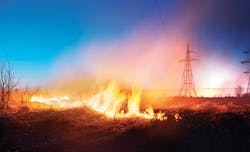There are many good reasons to keep vegetation in check: to maintain passable rights of way, to preserve drivers’ visibility near roadways, to clear away invasive species. The article on page 24 of this issue touches on all of these, but one of them is particularly relevant at the moment.
Maintaining the right of way—whether for vehicles or for utility lines—is a serious business. As the article notes, in California alone, utilities spend over a billion dollars a year just to trim trees. The California Public Commission’s deputy executive director for safety and enforcement policy notes that California has the most stringent vegetation management requirements in the US. And yet, lately, that hasn’t been enough.
In the last two years, the state has lost millions of acres, billions of dollars, and dozens of lives to wildfires, some of which have been blamed on tree branches coming into contact with power lines. The fires themselves have been devastating, and the associated erosion and mudslides scar the landscape and continue to cause damage long after the fires are out. PG&E, the company that owns some of those power lines and associated equipment, is looking at more than $30 billion in damages associated with the fires.
The company filed for bankruptcy protection earlier this year. It still has to deliver power, though, including to some extremely remote areas. As company officials and others have noted, utilities can’t charge significantly more to those out-of-the-way customers, even as they struggle to place and maintain equipment and high-voltage transmission lines to reach them.
The drought has exacerbated the problem, killing trees and leaving behind plentiful dry fuel. In the last issue, I mentioned a proposal by the California Department of Forestry and Fire Protection to thin the state’s forests. That proposal has met with objections—some from critics who say it won’t be enough, others who claim it might make the problem worse by encouraging the wrong—less fire-resistant—plants to grow.
The proposal PG&E and other utilities have come up with to limit the risk, however, is causing sparks of its own throughout the state: shutting down power during periods of high wind or very low humidity in high-fire-risk areas. The outages, which could affect as many as five million people, might last for up to five days at a time, and this pattern could continue for as long as five years while PG&E clears trees and other vegetation and works to make its transmission system safer. Even customers who don’t live in high-risk zones might still lose power if their transmission or distribution lines pass through such areas. Other utilities such as Southern California Edison and San Diego Gas & Electric are adopting similar protocols.
If the situation plays out as PG&E predicts, there will likely be increased demand for generators. PG&E has said it will create “resilience zones” in the affected areas, where it will provide generators to keep a few services open and where people can charge cell phones, but utilities most likely will not pay for any expenses incurred as a result of the outages—lost business revenue, spoiled food, and so on.
Although most of us aren’t involved in fighting wildfires directly, much of what we do—managing vegetation, limiting erosion in the burned areas—determines what happens before and after. If you’re in a fire-prone area, have you seen changes in policy or practice prompted by California’s experience? Send your comments to [email protected].
Janice Kaspersen
Janice Kaspersen is the former editor of Erosion Control and Stormwater magazines.






